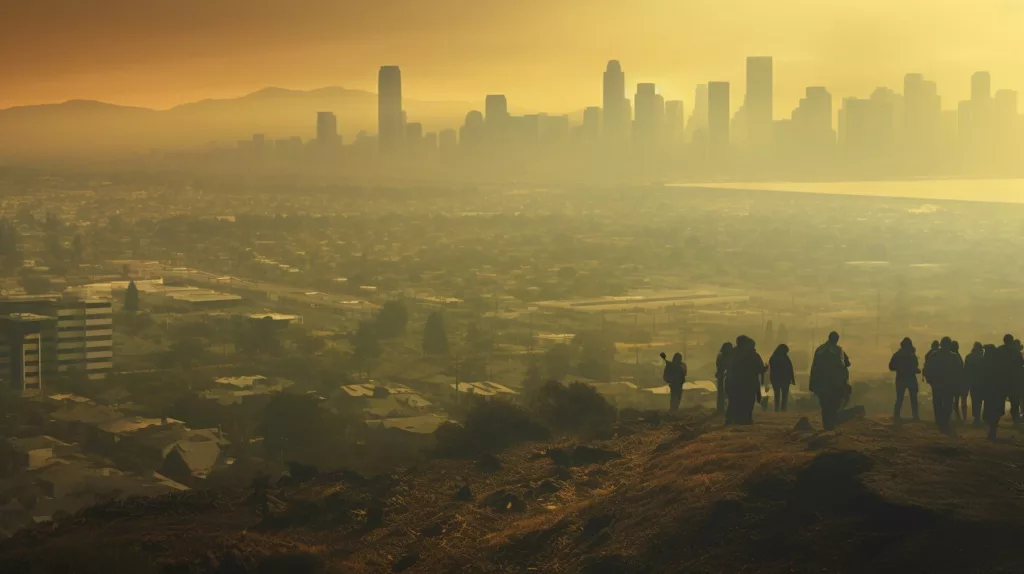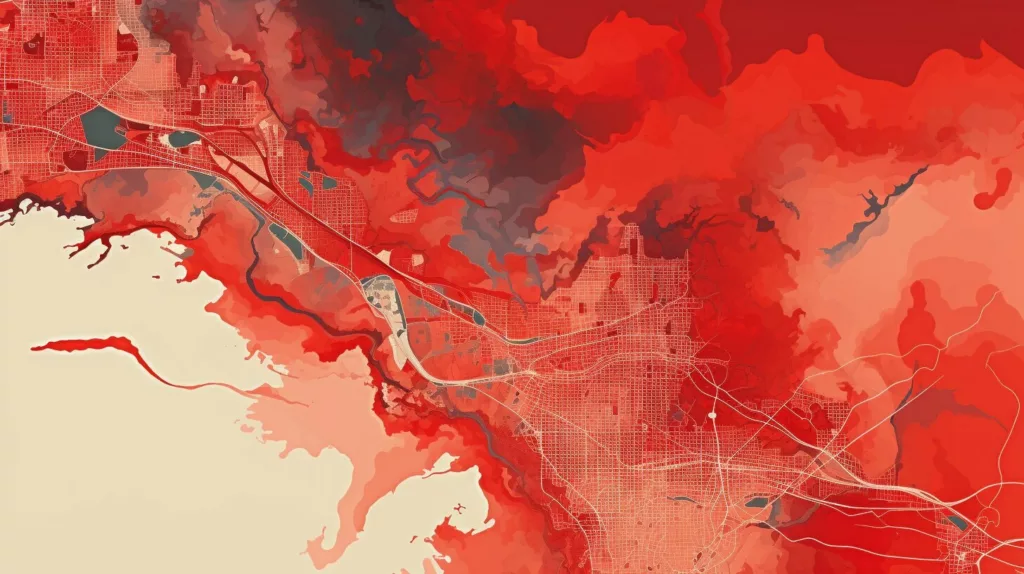Understanding Air Pollution Bay Area: Risks & Solutions
If you live in the Bay Area, you are likely familiar with the haze that often blankets the region, especially during wildfire season. Unfortunately, air pollution in the Bay Area is not limited to just these intermittent events – it is a persistent problem that poses significant risks to both the environment and public health.
In this section of our article, we will provide you with a comprehensive overview of the state of air pollution in the Bay Area. We will explore its causes, environmental and health risks, and practical solutions that you, as an individual, can take to help reduce this issue.

- Air pollution in the Bay Area is a persistent problem that poses significant risks to both the environment and public health.
- Causes of air pollution in the Bay Area include natural and human-made sources, such as vehicle emissions, industrial pollution, and wildfires.
- Environmental and health risks associated with air pollution in the Bay Area include damage to ecosystems, wildlife, respiratory and cardiovascular health, and overall well-being.
- Effective solutions for reducing air pollution in the Bay Area include promoting clean transportation, supporting renewable energy, advocating for stricter environmental regulations, and fostering community engagement.
- Ongoing initiatives and programs aimed at reducing air pollution in the Bay Area are helping to drive progress toward a cleaner future.
Air Pollution Bay Area: An Overview
Air pollution is a significant problem in the Bay Area, with many areas often exceeding federal air quality standards. The region is known for its frequent incidence of smog and haze, which can significantly impact visibility and air quality. The Bay Area Air Quality Management District is responsible for monitoring and regulating air pollution in the region.
The geographical extent of air pollution in the Bay Area varies, with some areas more affected than others. According to recent data, the East Bay and parts of San Francisco experience higher levels of pollution than other regions. The map below illustrates the distribution of air pollution across the Bay Area.

The map highlights the areas with the highest concentrations of pollutants, which are often close to major roadways and industrial centers. However, air pollution can also be carried over longer distances, affecting even rural areas in the region. The Bay Area’s unique topography, including its valleys and hills, can also contribute to the severity of air pollution in some areas.
Ambient Air Quality Standards in the Bay Area
The Bay Area Air Quality Management District has established ambient air quality standards that are based on federal guidelines and reflect the health risks associated with exposure to different pollutants. The most common pollutants that are monitored in the area include:
| Pollutant | Ambient Air Quality Standard |
|---|---|
| PM2.5 | 35 µg/m³ (24-hour average) |
| Ozone (O3) | 70 ppb (8-hour average) |
| Nitrogen Dioxide (NO2) | 100 ppb (1-hour average) |
| Sulfur Dioxide (SO2) | 75 ppb (1-hour average) |
While these standards are designed to protect public health, they are not always met, particularly during periods of high pollution. Individuals who are concerned about air quality in their area can check the current air quality readings and forecasts on the Bay Area Air Quality Management District’s website.
Causes of Air Pollution in the Bay Area
Air pollution in the Bay Area is a complex issue with numerous sources and contributors. Natural factors such as wildfires and seasonal changes in weather patterns play a significant role in exacerbating air pollution levels. However, human-made activities are the primary cause of air pollution in the region.
The largest contributor to air pollution in the Bay Area is transportation, accounting for over half of all emissions. The numerous cars, trucks, and buses on the roads release pollutants such as nitrogen oxides, particulate matter, and volatile organic compounds into the air. Industrial activities, such as oil refining and manufacturing, also release significant amounts of pollutants, contributing to high levels of air pollution in areas near these facilities.
Wildfires are another significant source of air pollution in the Bay Area. Smoke and particulate matter released during large wildfires can travel long distances, impacting air quality even in areas far from the fires themselves. Climate change is also causing more frequent and severe wildfires, further exacerbating the issue of air pollution in the region.
Other sources of air pollution in the Bay Area include residential and commercial heating, construction activities, and agriculture. These activities release pollutants such as carbon monoxide, sulfur dioxide, and ammonia, contributing to the overall poor air quality in the region.

Addressing the causes of air pollution in the Bay Area requires a multi-faceted approach that involves both individual and collective action. By reducing reliance on cars, supporting renewable energy sources, and advocating for stricter environmental regulations, we can greatly reduce the amount of pollution released into the air.
Environmental Risks of Air Pollution in the Bay Area
Air pollution in the Bay Area has far-reaching consequences for the environment. Polluted air can harm the health of plants, animals, and entire ecosystems. One of the most significant environmental risks of air pollution is acid rain, which occurs when sulfur dioxide and nitrogen oxide mix with water vapor in the air and fall as acidic precipitation. Acid rain can damage crops, forests, and bodies of water, causing long-term ecological damage that can take years to reverse.
Another major risk is the depletion of the ozone layer, which protects the planet from harmful ultraviolet radiation. Air pollutants such as chlorofluorocarbons (CFCs) and nitrogen oxides contribute to ozone depletion, which can have dire consequences for the health of the planet and its inhabitants.
The increased occurrence and severity of wildfires in the Bay Area is also a direct result of air pollution. The dry, hot conditions caused by pollution create the perfect environment for fires to start and spread, leading to devastating consequences for the environment and surrounding communities.

Additionally, air pollution can harm wildlife, particularly those living in and around bodies of water. Polluted air can lead to reduced oxygen levels in water, making it harder for aquatic animals to breathe. It can also lead to the accumulation of harmful toxins in water, which can poison fish and other animals that live there.
Overall, the environmental risks of air pollution in the Bay Area are severe and far-reaching. It is essential that individuals and communities work together to address this issue and take proactive steps towards a cleaner, healthier future.
Health Risks of Air Pollution in the Bay Area
If you’re living in the Bay Area, you may be exposed to hazardous air pollutants on a daily basis. Unfortunately, long-term exposure to air pollution can have serious negative effects on your health.
Respiratory health is particularly susceptible to the effects of air pollution. Fine particulate matter, a common pollutant in the Bay Area, can aggravate asthma, cause lung irritation, and even lead to chronic obstructive pulmonary disease (COPD). Long-term exposure has also been linked to an increased risk of lung cancer.
Exposure to air pollution can also have a significant impact on cardiovascular health. High levels of pollutants like ozone and nitrogen dioxide have been associated with an increased risk of heart attacks, strokes, and other cardiovascular diseases. Additionally, air pollution has been linked to premature birth and low birth weight in newborns.
Residents of densely populated areas like San Francisco are particularly at risk for negative health effects of air pollution, as they are often exposed to higher levels of pollutants due to traffic congestion and other factors.

It’s important to take necessary precautions to protect your health from the harmful effects of air pollution in the Bay Area.
One way to stay informed about current air quality levels is by checking the Bay Area Air Quality Management District website. You can also download mobile apps that provide real-time air quality information and alerts, such as AirVisual and AirNow.
When air quality is poor, it’s essential to limit outdoor activities and avoid exercising outdoors. Wearing a mask can also help reduce exposure to pollutants.
Ultimately, the most effective way to protect your health from air pollution in the Bay Area is to advocate for proactive measures to improve air quality. Supporting clean transportation, promoting renewable energy, and advocating for stricter environmental regulations are all ways that individuals can make a difference.
Monitoring Bay Area Air Quality
It’s important to stay informed about the current state of air quality in the Bay Area, especially if you have underlying health conditions or are planning outdoor activities. You can check Bay Area air quality today and stay up-to-date with Bay Area air quality forecasts by visiting the AirNow website, which provides real-time air quality data and forecasts for cities across the United States.
Additionally, many local news channels and organizations offer regular updates on air quality conditions in the Bay Area, particularly during wildfire season when air quality can change rapidly. It’s crucial to pay attention to these updates and take necessary precautions to protect your health.

Remember, even on seemingly clear days, the air quality in the Bay Area could still be compromised. Checking the air quality forecast and taking precautions such as wearing an N95 mask or limiting outdoor exposure during high pollution days can significantly reduce your risk of exposure to harmful pollutants.
Taking Action: Solutions for Cleaner Air
If you want to make a difference in reducing air pollution in the Bay Area, you don’t have to look far. There are many proactive steps you can take to help improve air quality in your community and beyond.
1. Choose Clean Transportation
One of the biggest contributors to air pollution in the Bay Area is transportation, particularly cars. By choosing cleaner transportation options, such as biking, walking, carpooling, or taking public transit, you can significantly reduce your individual carbon footprint and help keep the air cleaner for everyone.
2. Support Renewable Energy
Another way to reduce air pollution is to support clean, renewable energy sources such as solar and wind power. Look for ways to incorporate renewable energy into your daily life, such as installing solar panels on your home, supporting local renewable energy initiatives, or advocating for renewable energy policies.
3. Advocate for Stricter Environmental Regulations
One of the most effective ways to combat air pollution is to support stricter environmental regulations and policies. Contact your elected officials and urge them to take action on air pollution and support policies that prioritize clean air and public health.
4. Foster Community Engagement
Working together as a community is essential to reducing air pollution in the Bay Area. Join local advocacy groups, participate in community events and initiatives, and encourage your friends and family to get involved in creating a cleaner, healthier environment.

By taking these proactive steps, you can make an impact in reducing air pollution in the Bay Area and create a brighter, cleaner future for everyone.
Initiatives for Air Pollution Reduction in the Bay Area
To tackle air pollution in the Bay Area, there are various ongoing initiatives and programs in place.
One such initiative is Spare the Air, a program established by the Bay Area Air Quality Management District (BAAQMD) to reduce air pollution levels and protect public health. The program provides real-time air quality updates and alerts, promotes alternative transportation options, and advocates for energy-efficient practices.
The Clean Cars for All program is another initiative aimed at reducing vehicle emissions in the Bay Area. The program provides incentives for low-income residents to replace their old, high-emission vehicles with new or used electric vehicles or plug-in hybrids.
The Bay Area Climate Collaborative is a public-private partnership that focuses on accelerating the deployment of clean energy and transportation solutions. The collaborative works with businesses, government agencies, and community groups to promote renewable energy adoption, support clean technology development, and advance sustainable transportation solutions.
Another notable initiative is the San Francisco Clean Energy Program, which aims to power the city with 100% renewable energy by 2030. The program incentivizes the use of renewable energy sources, such as solar and wind power, and supports the development of innovative technologies to reduce energy consumption and emissions.

These and other initiatives are crucial in the fight against air pollution in the Bay Area. By working together, we can make significant progress towards a cleaner and healthier future.
Conclusion
Now that you have a comprehensive understanding of air pollution in the Bay Area, it’s clear that taking action to reduce pollution levels is critical. By implementing the solutions discussed throughout this article, we can work towards a cleaner and healthier future for our communities.
Remember Your Role
As an individual, you play a critical role in reducing air pollution in the Bay Area. By making conscious choices to decrease your carbon footprint and advocating for cleaner energy solutions, you can contribute to a cleaner environment and healthier community.
Take Action Today
Check the Bay Area air quality today, minimize driving, carpool, bike, and use public transportation wherever possible. You can also support renewable energy initiatives, reduce water use, and promote sustainability in your workplace or community group.
By working together and taking meaningful action, we can achieve cleaner air and a healthier Bay Area for generations to come.
Happy Learning
Also, Read,
Stylish Frameless Shower Doors
Euro Pillow – Upgrade Your Sleep
FAQ
What is air pollution?
Air pollution refers to the presence of harmful substances in the air that can have detrimental effects on the environment and human health.
How does air pollution affect the Bay Area?
Air pollution in the Bay Area can lead to reduced air quality, contributing to health issues such as respiratory problems and increased risk of heart disease.
What are the main causes of air pollution in the Bay Area?
The main sources of air pollution in the Bay Area include vehicle emissions, industrial pollution, and wildfires.
What are the environmental risks of air pollution in the Bay Area?
Air pollution can harm ecosystems, disrupt wildlife habitats, and contribute to climate change in the Bay Area.
How does air pollution impact human health in the Bay Area?
Exposure to air pollution can lead to respiratory issues, cardiovascular problems, and other health concerns in the Bay Area.
How can I monitor air quality in the Bay Area?
Residents can check current air quality levels in the Bay Area through various tools and resources available online. It is also important to pay attention to air quality forecasts.
What can I do to help reduce air pollution in the Bay Area?
Taking actions such as using clean transportation, supporting renewable energy, and advocating for stricter environmental regulations can contribute to reducing air pollution in the Bay Area.
Are there any initiatives addressing air pollution in the Bay Area?
Yes, there are ongoing initiatives and programs led by the government, industry collaborations, and community organizations aimed at reducing air pollution in the Bay Area.
What is the importance of collective action in addressing air pollution?
Collective action is crucial in combating air pollution as it requires the cooperation and efforts of individuals, communities, and policymakers to create a cleaner and healthier Bay Area.



